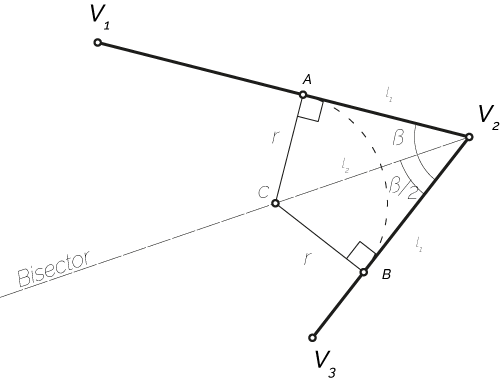Ok, Xenapior and Reynolds together have the right idea. But the explanation is a bit lacking so here is a image to explain it all and some further musings. First let us start by drawing an image (yes i know that is what they say in school for you to do but nobody does it).

From the image we can see that there are 2 equal right triangles $V_2, A, C$ and $V_1, B, C$. In this triangle we have one unknown that we can define namely rounding radius $r$, also we know right angle is 90°. The angle between the line $V_1-V_2 = \vec a$ and line $V_2-V_3 = \vec b$ is easy to compute with the formulation fo angle between vectors
$$\cos(\beta) = \frac{\vec a·\vec b}{ |\vec a|·|\vec b|}$$
That in turn can be simplified if the vectors already are normal. Thus three things of the triangle is known, which means all is known. So if you know the rounding radius to use the calculating the points $A$, $B$ and $C$. So finally:
a = normalize(V2-V1);
b = normalize(V2-V3);
halfang = acos(dot(a, b))/2.;
// skip center if you iuse splines
C = V2 - r / sin(halfang) * normalize((a+b)/2);
A = V2 - r/tan(halfang)*a;
B = V2 - r/tan(halfang)*b;
You can simplify this a bit with trigonometric identities. Or if you use rational B-splines you can skip the calculation of C
Note: that this is only one possible formulation

